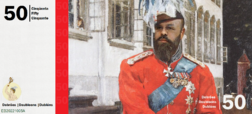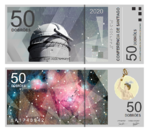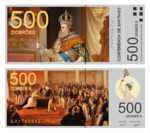Conferential doubloon
| Conferential Doubloon | |
|---|---|
 | |
| ISO 4217 | |
| Code | CSD |
| Denominations | |
| Plural | Doubloons (Pt: Dobrões, Fr: Dublóns) |
| Symbol | Δ, 𝛿 |
| Demographics | |
| Official user(s) | |
| Unofficial user(s) | |
| Issuance | |
| Central bank | CS Financial Authority (CSFA) |
| Printer | CSFA and authorized institutions |
| Mint | CSFA and authorized institutions |
| Valuation | |
| Pegged with | Pyrite standart |
The Conferential Doubloon (Portuguese: Dobrão Conferencial, French: Dublón de Conferénce; Sign: Δ), shorthened as CS Doubloon, is the official currency of 11 of the 21 member states of the Conference of Santiago (CS). The currency has also been unilaterally adopted by New Essex. The currency draws it value at a fixed exchange rate in the grammage of pyrite, owing to the reserve of 27kg of pyrite maintained by the Conference of Santiago Financial Authority, the institution responsible for its monetary policy. The Doubloon is subdivided into 100 dobras (𝛿).
Etimology
The name "Conferential Doubloon" was first brought by King Arthur II of Eebenthal. The name makes reference to the currency's issuing organization on calling it "Conferential", while "Doubloon" is a reference to the ancient Doubloon, a gold coin which was issued both by Portugal and Spain, and which therefore refers to the member states of the Conference of Santiago at the time, located in Ibero-America and whose resident populations are native speakers of Portuguese and Spanish.
History
Background
The Conference of Santiago was founded in 7 April 2020 as an intermicronational organization aiming to provide a "safe heaven" and to promote the relations and development of secessionist micronations within the then recently-established Brazilian sector, as opposed to the secessionist-hostile simulationist-dominated Lusophone sector. The creation of a common currency was first proposed at the 1st CS Plenary Summit, shortly after the creation of the organization. The objective was to integrate Brazilian micronations and develop, in a joint effort, the aspect of micronational economies, which was very little addressed. However, more pressing matter such as the ensuing Santiago-Mansean Conflict delayed the development of the project. Finally in 27 July 2020 King Arthur II of Ebenthal presented before the CS Plenary a common currency project, the Conferential Doubloon. The project was almost unanimously approved, with only the opposition of the United Provinces of Mauritia delegation. Following the 4th CS Plenary Summit, on 2 August 2020 the Conference Doubloon was formally established together with the Conference of Santiago Financial Authority (CSFA). To support the new common currency, the Government of Ebenthal donated 27kg of pyrite to the Financial Authority, and the grammage of this metal became the determinant of the currency's conversion value.
International reaction
As soon as the currency was officialy established and announced, the project was praised by other micronations allied with CS member states such as the Grand Republic of Delvera, the North American Confederation, the State of Vishwamitra and the Empire of Pavlov. The Sovereign House of Mithras not only praised the currency and economic project as showed interest in participating in the project and the Conference of Santiago while the Duchy of New Wessex deliberately asked for permission to adopt the doubloon as the country's official currency, which sparked a debate at the Conference about the implementation of monetary agreements to allow non-conference members to adopt the currency for official use. Other non-CS member states micronations also adopted the currency in official capability, such as the New Southern Rhine, albeit it later joined the organization.
Plans and expansion
In August 2021, as the Doubloon celebrated one year of existence, the Chancellor of Mauritia suggested that the currency be replaced by a cryptocurrency, or that the Conference create its own cryptocurrency. This is because the indexed value of the conversion into the pyrite standard inhibited the practical adoption of the currency by some of the micronations. The idea, although not entirely dismissed by then, was converted into the transformation of the Conferential Doubloon into a cryptocurrency. However, as President of the CS Financial Authority, the King of Ebenthal presented a counter-proposal in order to allow the real adoption of the currency by other micronations, which is to back it up through reserves of any metals and convert their value for printing currency according to the value of the pyrite grammage. This proposal, however, was only formally introduced in mid-2023 by order of the Secretary-General of the Conference of Santiago Queen Maria I of Sildavia. Subsequently, a new series of Doubloon banknotes was adopted in commemoration of the coin's three-year anniversary.
Monetary policy
The CS Doubloon is managed and administered by the Conference of Santiago Financial Authority (CSFA) and the Financial Authority Board, composed of the central banks of the Doubloon-adopting CS member states. As an independent central bank, the CSFA has sole authority to set monetary policy. The Board participates in the printing, minting and distribution of currency in all member states, and the operation of the conferential payment system. The monetary system adopted by the CSFA consists of backing the value of currency to the value of the pyrite decigram. By direct order of the President of the CSFA, instructed by the Secretariat of Treasury, the value of backing was stipulated in the decigram, and not in the gram of the metal, as a way of safeguarding private investors who invest in the Financial Authority, making the currency cheap to maintain, but not enough to make it commercially unviable or uninteresting.
Exchange rates and value
The CS Doubloon makes use of the pyrite standart, being backed by a reserve of 27 kg of pyrite, at the fixed exchange rate of 1 Kupfermark to 1 pyrite gram. Conversion to other currencies is done through the value of the amount of copper referring to the amount to be exchanged in CS Doubloons. The currency is convertible to any currency, but the exchange commonly takes place between the value of pyrite (accordingly to what it is owed in CS Doubloons) and the Brazilian Real, US Dollar, Canadian Dollar and Euro.
Conversion diagram: 1 CS Doubloon = 1 pyrite gram = the value of a gram of pyrite in the currency to be exchanged.
| Year | Pyrite Gram Exchange rate | ||||||
|---|---|---|---|---|---|---|---|
| 2022 | 1 gram | Δ1,00 | R$0,0082 | $0,0017 | CA$0,0023 | £0,0013 | €0,0016 |
Banknotes
The first series os the CS Doubloon banknotes were officially launched on 2 August 2020. The banknotes were designed by King Arthur II and approved at the 4th CS Summit. The images used in the banknote design represent values cherished by the Conference of Santiago. That series also included braille for visually impaired people.
First series
Second series
The second series of CS Doubloon banknotes were officially released on 2 August 2023, celebrating the currency's release three-year anniversary. The banknotes were designed by King Arthur II and approved by the Secretary-General. The reverse always present a painting of the god Hermes, one of the symbols of the Conference of Santiago along with the armillary sphere.
| Image | Value | Dimensions (millimetres) |
Main Colour | Design | |||
|---|---|---|---|---|---|---|---|
| Obverse | Reverse | Obverse | Reverse | ||||

|

|
Δ3 | 136.8 x 64.9 | Dodger blue | "Saint Augustine in His Study" (1480) by Sandro Botticelli | "Conference Icone of Hermes" (2023) by Arthur van der Bruyn | |

|

|
Δ5 | 136.8 x 64.9 | Forest green | "Santiago meets the World" (2023) by by Hans Scherer | "Conference Icone of Hermes" (2023) by Arthur van der Bruyn | |

|

|
Δ10 | 136.8 x 64.9 | Amber | "Mapa de Terra Nova e Labrador" (1570) by Fernão Vaz Dourado | "Conference Icone of Hermes" (2023) by Arthur van der Bruyn | |

|

|
Δ20 | 136.8 x 64.9 | Eminence | "Amerigo Vespucci Giving Reports of His Voyages to Queen Isabella of Spain" (2019) by Severino Baraldi | "Conference Icone of Hermes" (2023) by Arthur van der Bruyn | |

|

|
Δ50 | 136.8 x 64.9 | Crimson | "João de Noronha" (2022) by Lucas Othonsen | "Conference Icone of Hermes" (2023) by Arthur van der Bruyn | |

|

|
Δ100 | 136.8 x 64.9 | Flame | "Hermes and the Sphere" (2023) by Arthur van der Bruyn | "Conference Icone of Hermes" (2023) by Arthur van der Bruyn | |
Special series
| Banknotes: First Special Series (2 August 2020 - 1 August 2023) | ||||||||||||||
|---|---|---|---|---|---|---|---|---|---|---|---|---|---|---|
| ||||||||||||||







